Snapchat marketing is a direct line for brands to engage and build trust with younger audiences.
The network has over 900 million monthly active users as of 2025, and continues to grow in popularity, with Gen Z and younger millennials using Snapchat daily to connect with friends, family and creators. This presents an opportunity for brands to become part of these conversations through ephemeral content and influencer partnerships.
In this article, we share Snapchat’s core features, tips on how to build your Snapchat marketing strategy and highlight brands already making an impact on the network.
What is Snapchat marketing?
Snapchat marketing is a digital marketing strategy that uses the network’s features and advertising tools to attract an audience and grow your bottom line. The key is to create strategies that work with how users naturally engage on the network.
For brands catering to Gen Z or younger millennials, Snapchat marketing offers a significant opportunity to impact your business. Snapchat reaches 90% of 13 to 24-year-olds and 75% of 13 to 34-year-olds in more than 25 countries, making it one of the most effective networks for brands looking to target Gen Z and younger Millennials.
Beyond the user base, what sets Snapchat apart is how it’s used. Snapchat’s 2024 How We Snap Report, found that users connect (59%) and share content (49%) with friends and family on Snapchat more than any other social network. They also open the app more than 30 times a day, showing how central Snapchat is to communication and decision-making.
The frequency of use and intimacy make Snapchat a valuable space for brands to engage younger audiences in a way that feels authentic.
To start using Snapchat for marketing, your brand will need a public profile. If you want to run ads, access analytics through Snapchat Insights or unlock features like creating AR Lenses, you’ll also need a Snapchat Business account.
Let’s go through Snapchat’s core features and how to use each one strategically.
Stories
Stories are Snapchat’s most versatile feature. They’re short (up to a minute), vertical video or image Snaps that disappear after 24 hours, and they’re useful. Stories can support just about any marketing goal, from driving traffic to boosting engagement.
The key is to keep Stories casual, timely and built around a strong hook. Netflix gets this right. The example shows how they use Stories to promote new shows like KPop Demon Hunters.
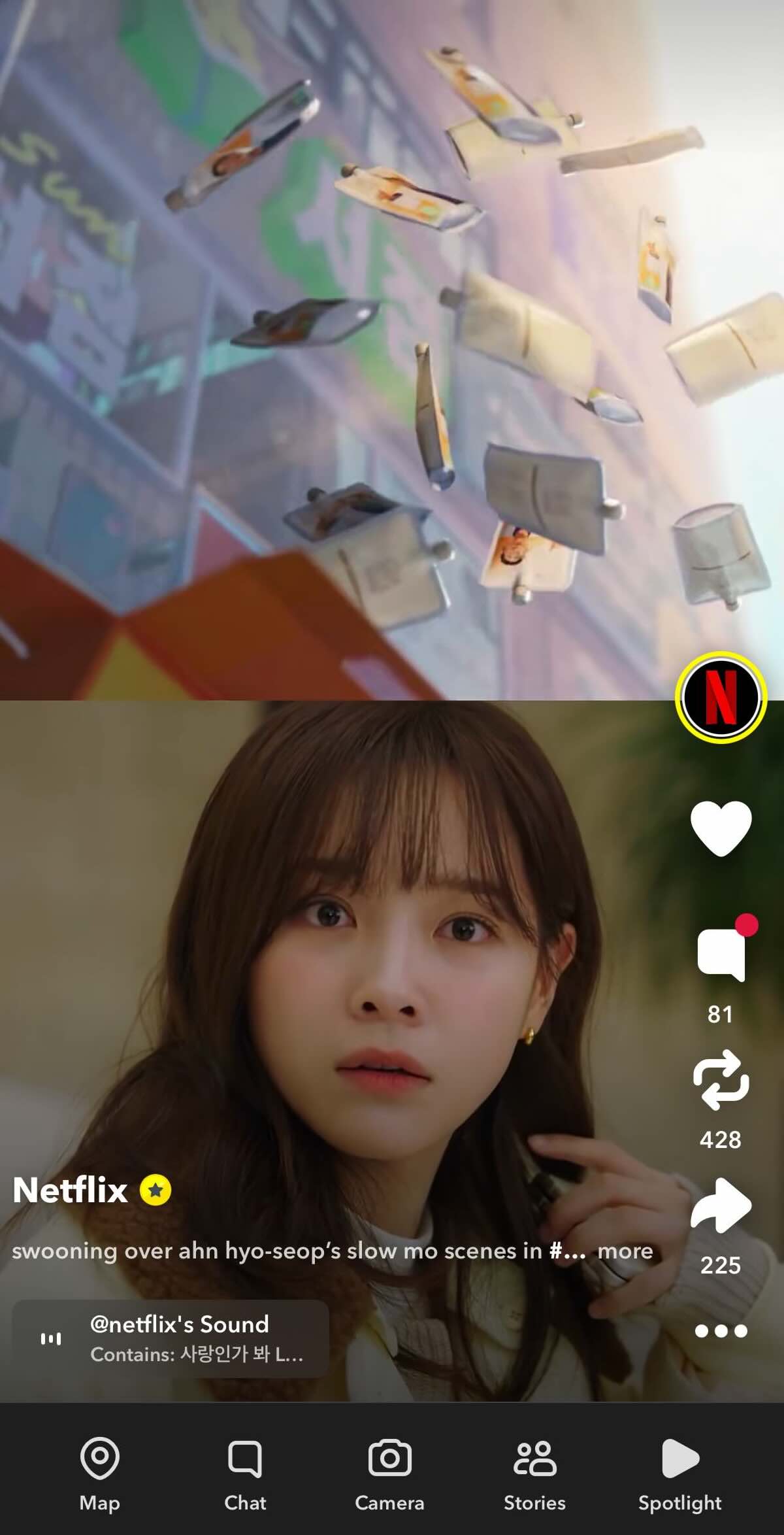
One feature of Stories is that you can add swipe-up or tap-through links if you have a Snapchat Business account. This allows viewers to take direct action, making Stories a valuable tool in your broader Snapchat marketing strategy.
Saved Stories (Story Highlights)
Saved Stories, or story highlights, let you pin select content to your public profile so it doesn’t disappear after 24 hours.
Treat it as your “About Us” section on Snapchat. It should be evergreen content that helps new viewers quickly get a feel for your brand. Bumble, for example, uses Saved Stories to share dating tips and brand values, providing a clear snapshot of what it stands for.
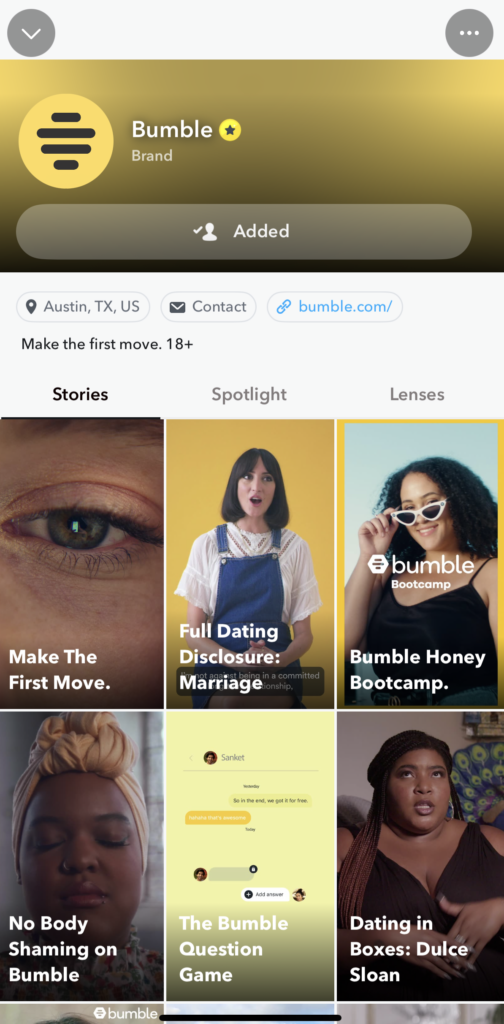
Spotlight
Spotlight is Snapchat’s answer to scrollable short-form video. Public profiles can submit video Snaps to Spotlight, giving brands a chance to expand the reach of their Snapchat marketing without adding budget. Spotlight is also a good place to repurpose vertical content that has performed well on other networks (just be sure to remove the watermark) or test new creative.
If your video is selected, it appears on the Spotlight feed and on your Spotlight tab, giving your brand a credibility boost and wider exposure. Spotlight content tends to perform best when it features relevant trends, leads with personality and fits Snapchat’s casual tone.
Discover
Discover is Snapchat’s curated content feed featuring Stories from media partners, creators and sponsored brand content. It’s personalized to each user’s interests and engagement history, offering a prime spot for visibility.
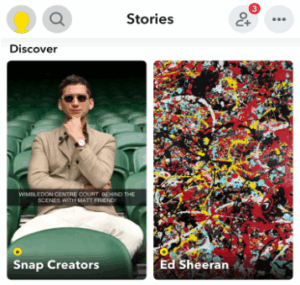
While organic Stories from public profiles don’t appear in Discover, your brand’s Snap Ads and Sponsored Stories do, putting you alongside trusted content creators. This is what makes Discover one of the best ways to connect with users already looking to engage.
AR Lenses
AR Lenses are Snapchat’s signature feature. They are interactive, enabling users to try on products, play branded games or explore immersive 3D animations.
As an example of a seasonal approach, Carhartt created a gamified Santa Lens where users dressed as Santa flew over homes dropping Carhartt products onto houses. Branded AR Lenses like these are fun and memorable, making them a smart way to promote products and enhance brand awareness and engagement.
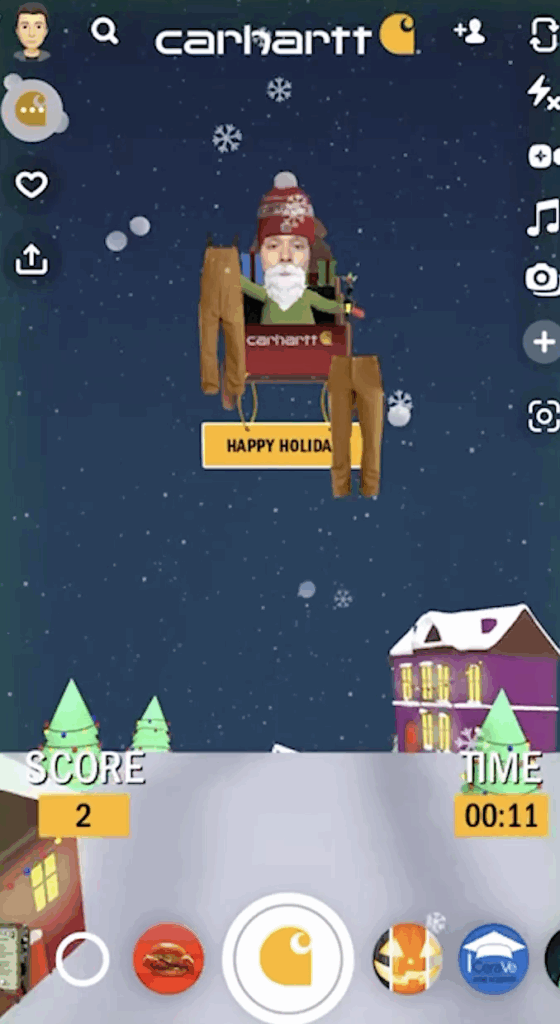
Filters
Filters are static overlays that users can add to a Snap after it’s taken, like frames, color treatments or location-based tags. Branded Filters are best used to boost visibility around product launches, holidays, events or store openings by encouraging shoppers to create user-generated content (UGC).
Why use Snapchat for business?
On Snapchat, the ephemeral nature of the content is valuable to brands. Stories vanish after 24 hours, and this drives immediate engagement compared to the slow-burning reach of in-feed content.
When paired with a user base comprising of Gen Z and Millennials who value unfiltered content, it essentially creates an environment where brands meet audiences that are eager to engage and connect.
Here’s a breakdown of how the ephemeral nature of Snapchat is helpful to brands.
Encourage brand engagement
Ephemeral content is one of Snapchat’s defining features and biggest engagement drivers. Because Stories disappear quickly, they create a built-in sense of urgency and trigger FOMO, prompting users to act fast.
The time limit also lowers the pressure to engage. When content feels temporary, it encourages more spontaneous views, clicks and replies. This low-stakes environment helps brands drive interaction in a way that feels native to the network.
Build trust through authenticity
Snapchatters value realness. Almost 80% say it’s where they are their “most authentic and real” selves. When brands meet their audience with the same level of authenticity, it creates deeper loyalty and stronger emotional connections.
A Sprout Social study found that 64% of consumers say they want to feel more connected to the brands they follow. Snapchat’s brand of ephemeral content removes the polish and pressure and delivers on that desire.
Reach Gen Z and Millennials easily
Three-quarters of Snapchatters are under age 35. This network gives you a direct line to Gen Z and younger millennials because Snapchat is already part of their daily habits.
Here are the top five daily activities on Snapchat:
- 66% Watch stories from friends and family
- 65% Send messages (to an individual or group)
- 60% Watch videos
- 58% Take pictures using the app camera
- 52% Watch stories from content creators
Posting content frequently that feels casual and spontaneous helps you match the way users already behave on the app.
If your goal is to connect with younger consumers, Snapchat helps you meet them on a network they already trust and use every day.
How to use Snapchat for business marketing
Snapchat has a lot to offer brands that use it strategically.
To do that, you’ll need clear goals, a keen pulse on your audience and a way to measure success. It’s also important to know which Snapchat features, influencers and ad formats align with your goals, because content alone won’t drive results.
A smart Snapchat marketing strategy uses the right tools to deliver the right message to the right people. Here’s how to make it happen.
1. Define your objectives
Your Snapchat strategy should ladder up to your broader social media goals. Here are some examples of what that could look like:
- To increase website traffic, use link sharing in Stories to drive users to your website.
- To boost brand awareness, use Discover or sponsored Lenses to reach a wider audience.
- Focused on loyalty? Partner with a creator or post more frequently on Stories to keep followers coming back.
Decide what Snapchat metrics you want to improve, and create content that will help you get there.
2. Know your audience
Creating a strong social media content strategy comes down to knowing who you’re talking to. Snapchat Insights give you access to audience demographics like age, gender, location and general interests so you can speak directly to the right people. Use this information to refine your content and tailor your creative accordingly.
If you’re working with creators, audience alignment matters just as much. Use Sprout’s Influencer Marketing solution to identify Snapchat influencers and review their Public Stories, Spotlight posts and past brand partnerships to make sure their audience and content align with your goals.
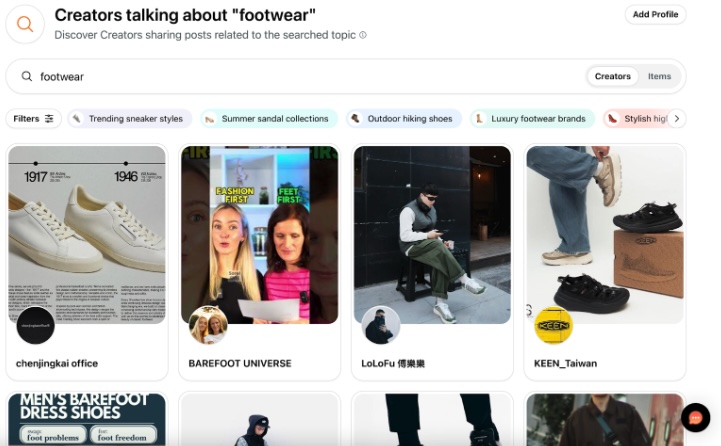
3. Create engaging content
The 2023 Sprout Social Index™ found that consumers want authentic, non-promotional content from brands, and Snapchat content is no exception to this.
People open the app to see and share real moments, so create content that reflects your brand while also meeting that expectation.
Here are some tips for creating engaging lo-fi content for Snapchat:
- Shoot vertically, and use movement, varied camera angles and POV shots to keep things visually dynamic.
- Add captions, filters, frames and music to match Snapchat’s casual, expressive style.
- Use stickers to give your audience a way to participate and make your Stories feel more like a two-way conversation.
- Focus on content that shows humor, challenges, behind-the-scenes moments or real customer experiences. According to the 2024 Social Media Content Strategy Report, 79% of consumers say relatable brand content has the biggest impact on their buying decisions.
Looking for ideas to get you started? Try behind-the-scenes stories about your products or people, tutorials, sneak peeks into upcoming launches or branded filters and lenses that inspire user-generated content.
4. Leverage Snapchat’s features
Snapchat offers creative tools to help your brand stand out. Each serves a different purpose, so make sure you’re choosing features that support your goals.
Lenses (AR filters)
Tre best used for brand engagement. These interactive filters let users play with your brand in a fun, immersive way. The average Snapchat user interacts with a Lens for at least 20 seconds, and is likely to share images or videos of themselves using the filter, turning branded content into promotional UGC.
Geofilters
Geofilters are ideal for location-based awareness and in-person engagement. These static or animated overlays appear when a user is in a designated area. Use them around storefronts, events or product drops to boost in-person engagement and visibility. For example, Adidas created a custom Geofilter to celebrate the reopening of its redesigned Oxford Street store in London.
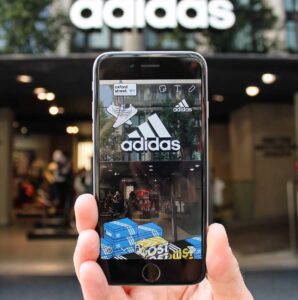
Discover and Spotlight
These are ideal for broadening reach. These areas give you a place to showcase content that’s more editorial, entertaining or creator-driven. Consider series-style Stories, branded storytelling or creator collaborations that fit Snapchat’s tone.
5. Engage in influencer and creator collaborations
Influencer marketing enables you to tap into built-in audiences and build credibility with younger users. The 2025 State of Influencer Marketing Report found that 86% of consumers make a purchase inspired by an influencer at least once a year, and Gen Z is most likely to make purchases based on influencer recommendations.
One option is a Snapchat takeover, where a creator posts directly from your brand’s account for the day. These takeovers encourage followers to engage and often include cross-promotion on the influencer’s own channels.
A tip to keep in mind: Make the takeover content exclusive to Snapchat. It might seem like a good idea to repost stories from another network, like Instagram, but you want to encourage people to follow along specifically on Snapchat.
Another strategy is to supply products for unboxings, demos or reviews and give creators the space to share their unbiased opinions. The more the content feels genuine, the more likely it is to build connection and drive action. The same report found that 47% of consumers said they want authenticity from influencers, even when posting sponsored content.
Whatever type of collaboration you try, aim to prioritize creators who already use Snapchat regularly and match your tone.
6. Invest in Snapchat ads
If you have an ad budget, Snapchat ads offer several ways to reach your audience and drive results. Snapchat ads combine formats (how an ad looks and behaves) with placements (where users see them).
Strong Snapchat ads capture attention fast. Keep them short, use motion, bold text and vertical design, use sound strategically and include a clear call to action.
For targeting, use Snapchat’s Ad Manager to reach users by location, interest, demographics or behaviors, and test different ad types to see what lands with your audience.
Here are the most common ad formats and what they’re best used for.
Sponsored Snaps
Sponsored Snaps are Snapchat’s most basic and widely used ad format. They are single-image or video ads that include a swipe-up CTA and are shown between Stories, Discover or Spotlight. Sponsored Snaps are a fast, full-screen way to drive action without complex creative.
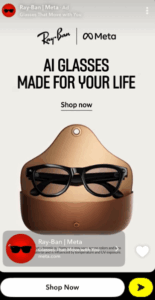
Collection ads
Collection ads are commonly used by e-commerce brands. These ads have shoppable, tappable tiles that link directly to products and are shown in the same places as sponsored Snaps.
Story ads
Full-screen, skippable vertical ads (3–20 frames) shown in the Discover tab. These ads are often paired with an interactive call-to-action link to drive brand awareness, app installs or conversions. Candy Crush ran a Story ad featuring a paid actor giving a testimonial as he plays the game, with a direct CTA to download the app.
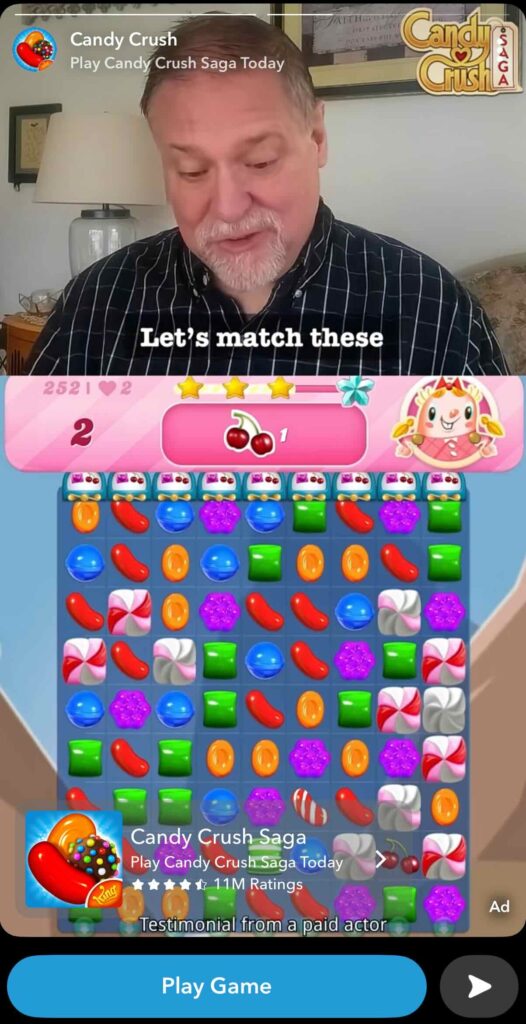
Sponsored filters and lenses
Boost reach and awareness with sponsored versions of Snapchat’s most engaging features, Filters and Lenses. These can be targeted by location or interest.
For example, the Superman movie promo featured a full sponsored Lens tab with multiple options, including a virtual movie theater experience co-branded with Toyota.
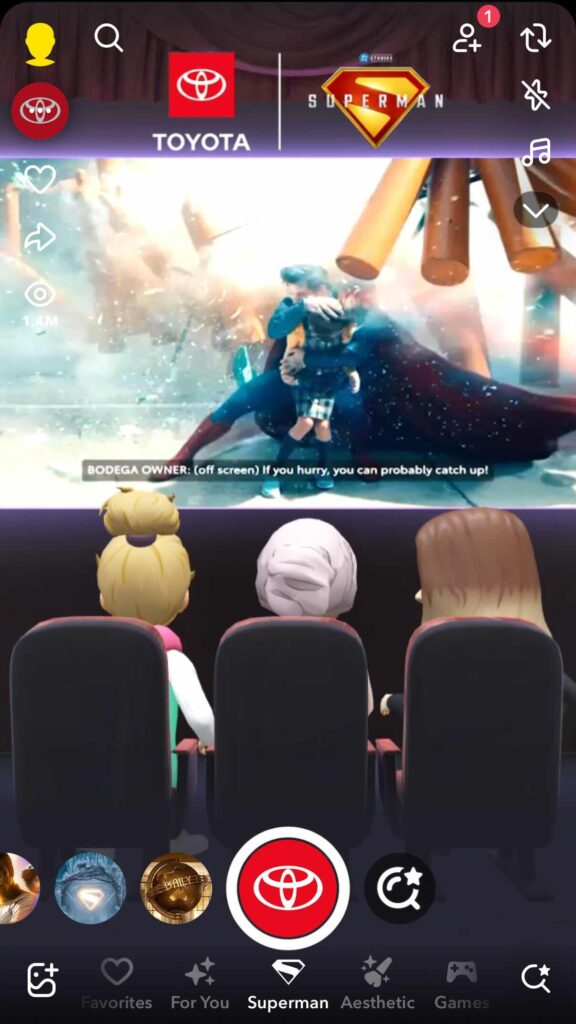
Commercials
Commercial ads only appear within curated shows on Snapchat Discover. These ads are non-skippable for the first 6 seconds and are ideal for high-impact brand awareness during premium content.
Lead generation ads
Lead gen ads include an embedded lead form, allowing Snapchatters to quickly share details like their email and name without leaving the app. They are great for service-based brands.
7. Measure and optimize
To measure success on Snapchat, you need to track performance consistently. Every Snapchat business account has access to Snapchat Insights, where you can monitor metrics like Story views, average view time, completion rate and audience demographics.
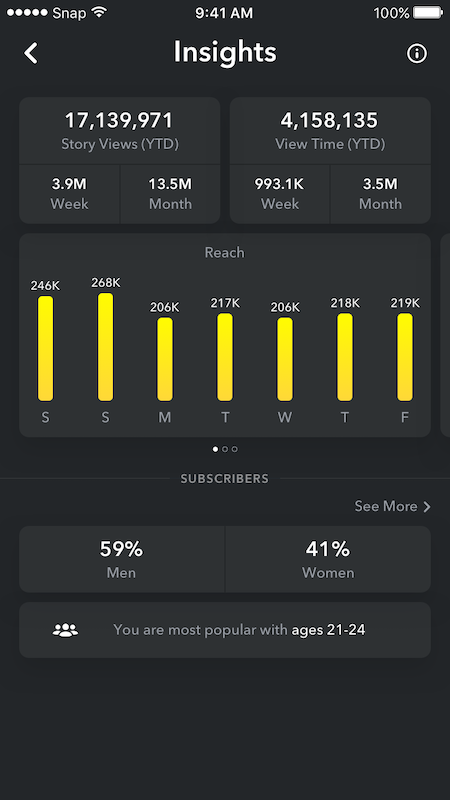
Start by setting benchmarks aligned with your goals and adjust accordingly. If a Story has a high open rate but low completion, test shorter or more visual content. Or if your goal is conversions, track swipe-ups or lead form completions. This is how you optimize for impact.
When partnering with creators, Sprout’s Influencer Marketing platform enables you to track influencer performance across Snapchat campaigns. You can also monitor metrics like views, shares, subscribers and engagement to better understand ROI and refine your strategy with every campaign.
Snapchat marketing strategy examples
Thanks to its playful features and highly engaged audience, Snapchat is full of creative marketing campaigns that brands are using to meet their goals. Here are some real-world Snapchat marketing strategy examples from top brands on Snapchat to inspire you.
The International Olympic Committee (IOC)
The IOC partnered with Snapchat to create a series of AR Lenses for the 2024 Olympic Games in Paris.
To celebrate 100 years since the Olympics were last held in the city, two of the Lenses blended archival visuals with iconic locations. Fans in Paris could walk down the Champs-Élysées or Rue de Rivoli and see them transformed into 1924 Paris. Meanwhile, global users got a glimpse of the original Yves-du-Manoir stadium (see below).
These kinds of immersive experiences show how you can use AR to bring people into a story, and gives you a glimpse into what’s possible when content meets context.

Hopper
Hopper, an app known for finding the best flight deals, ran static Sponsored Snaps that targeted users by location. Users saw deals from their own city, which worked. Snapchat users were 37% more likely to download the app and view a specific flight compared to users from other networks.
This campaign is a great example of how smart geo-targeting can drive results.
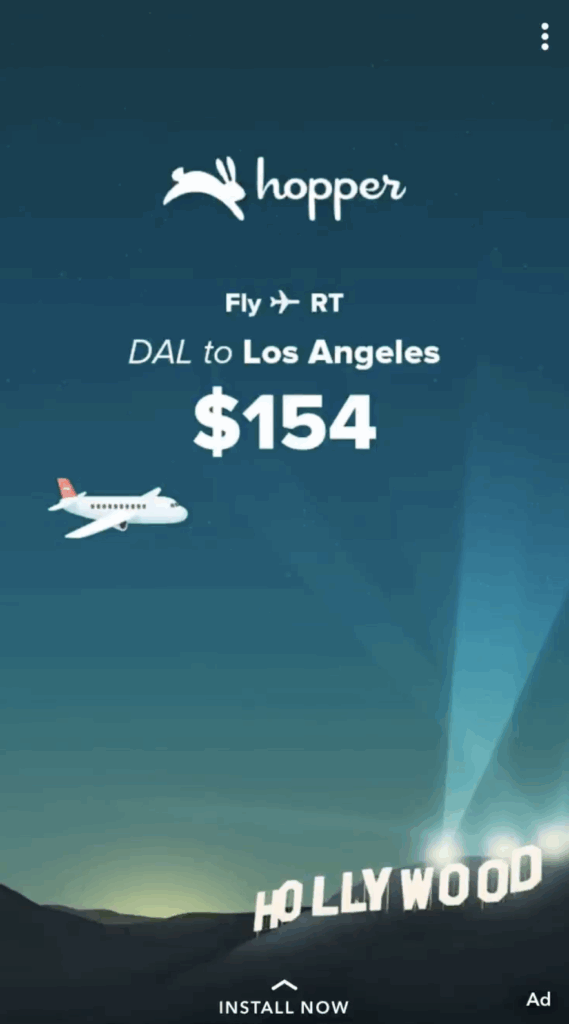
Gatorade
Gatorade brought its classic Super Bowl “Gatorade dunk” to Snapchat with a viral AR Lens. Snapchatters could open their mouths to dunk themselves, and send it to friends, turning a well-known sports moment into something fun and shareable.
The success of this Lens is proof that when you can turn a brand ritual into an interactive experience, people want to join in.

Temu
Temu nailed influencer marketing on Snapchat by paying creators around the world to show off their $0 hauls. The campaign promoted a deal where new users could get free items just by signing up and using an influencer’s code. It’s an offer that sounds too good to be true, but with trusted Snapchat creators behind it, people were more likely to convert.
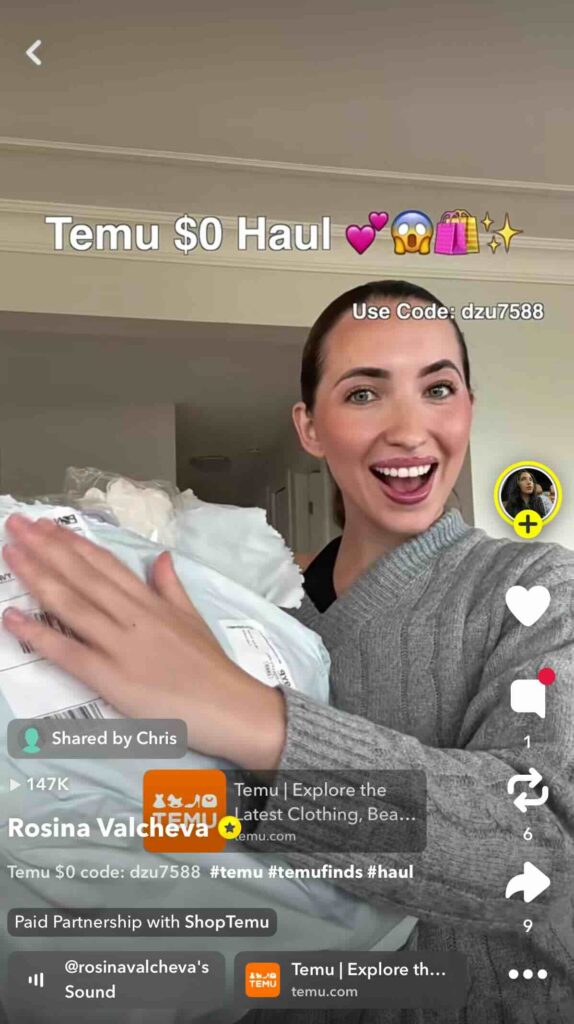

Embrace the future of Snapchat marketing
Used intentionally, Snapchat helps brands reach Millennials and Gen Z, drive traffic and influence purchase decisions.
As Snapchat grows, the demand for authentic, unpolished content remains strong. By prioritizing network-appropriate content, genuine storytelling and smart collaborations, your brand can stay ahead and capture lasting attention on this dynamic network.
To learn more about building credibility through strategic partnerships, explore our guide on Snapchat influencer marketing.
Frequently Asked Questions
How is Snapchat used for marketing?
Snapchat is used for marketing by creating quick, visual and in-the-moment content that feels natural to the way users already communicate. Brands use features like Stories, AR Lenses, Filters and influencer collaborations to enhance engagement and connect authentically with younger audiences.
Is Snapchat marketing worth it?
If your customers or clients are mostly Gen Z and younger Millennials, Snapchat marketing is absolutely worth it. With 75% of users under age 35 and high daily engagement, Snapchat helps brands build trust, spark real-time interaction and stay relevant through authentic ephemeral content and Snapchat Ads.
How much does it cost to promote on Snapchat?
Creating a public profile on Snapchat is free, and allows you to share content, grow an audience and showcase products.
If you choose to get a Snapchat Business account and run ads, the network lets you set your own budget, starting as low as $5 a day. However, Snapchat recommends spending at least $20 to $50 a day to optimize ad performance, especially during the initial learning phase of your campaign.
What marketing metrics are important for Snapchat advertising?
The marketing metrics that matter most will depend on your campaign goals, but the metrics below are all essential for evaluating performance and optimizing over time.
Amount Spent: Your total investment in the ad campaign so far. Shows what you’re investing and helps evaluate return on ad spend (ROAS).
Paid Impressions: How many times your ad has been viewed. Important for measuring reach and visibility.
Clicks: The number of times users tapped your ad or call-to-action. Measures if users are engaging with your content.
Video Views: The number of impressions where users watched at least two seconds or interacted with the ad. Useful for gauging attention and content relevance.
Swipe-Up Rate/Click-Through Rate (CTR): The percentage of impressions that resulted in a swipe-up or click. Helps determine how compelling your ad is to take action.
Conversions: The number of defined actions completed. This is critical for measuring the effectiveness of Snapchat marketing on your bottom line.
You can view all of these metrics in Snapchat Ads Manager.